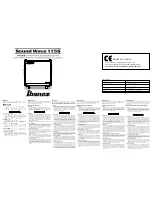
Operation Manual
CE2000TX
Power Amplifier
page 20
For the sake of simplicity, only channel one of
the amplifier is described.
Signal is presented to the CE 2000TX through
one of three connectors when using the stan-
dard input module. Each channel is outfitted
with a balanced XLR / phone jack and a barrier
strip. These connectors are wired in parallel,
which allows daisy chaining when needed. The
signal is then converted from balanced to
unbalanced in the Balanced Input Stage where
it also receives RFI protection. Signal then
flows into the Variable Gain Stage where the
front panel level controls are allowed to affect
the gain.
Following this stage, the signal is put under the
control of a full-time compressor circuit com-
prised of a symmetrical window detector, a
buffer amplifier, and the gating op amp which
uses several small components to set the com-
pressor’s attack and decay characteristics. The
actual compressing is accomplished by an
opto-isolator which affects the gain in the sig-
nal path.
Next the signal enters the error amplifier circuit,
where it is mixed with a small portion of the
output signal in such a way as to control the
amplifier’s overall output perfomance.
Following the error amp is the LVA stage, which
is where the low-voltage referenced signal gets
translated to the output high-voltage rails. The
last voltage amplifier, in conjunction with a
bootstrap current source, drives both predriv-
ers and the bias servo. The bias servo is
mounted in such a way as to translate the out-
put heatsink temperature into a controlled bias
current to prevent thermal runaway and hold
the amplifier’s notch distortion to a minimum.
The predrivers provide enough signal to acti-
vate the drivers, which together operate in the
class AB range. For the major output current
requirements, the drivers feed the various num-
bers of paralleled output transistors which
operate in a class B mode. This we call the Tri-
ple-Deep Darlington Output Stages.
The output transistors are protected by the Time
Dependent Voltage & Current circuit. This cir-
cuit protects the devices from extending
beyond their safe area of operation, but allows
the devices to provide high bursts of peak
power with music, allowing your amplifier to
deliver more punch. When all is said and done,
this amplifier output topology offers a good
combination of low quiescent amplifier heating,
great distortion performance at high powers,
and relative simplicity, with impressive reliabil-
ity and value.
All output power is delivered through 4-circuit
Speakon
®
connectors. These connectors have
been wired in such a way as to allow you the
most versatility. The Channel 1 and 2 connec-
tors are cross wired so you can cover all
options, from dual cable stereo (typical), to
Bridge-Mono in one connector, to running a bi-
amp speaker with one amplifier and one cable
per speaker cabinet.
The output relay, in conjunction with input sig-
nal mute circuit, assures the amplifier will be
well-behaved during turn on and off. In the
event of an amplifier output failure, a triac will
activate to turn off the offending channel and
protect your speakers.
The turn on delay circuit functions to keep the
output relay open until all the voltages are up
and stable, both in the amplifier, and in all the
components in the system ahead of the
amplifier.
Heatsink temperature is monitored by a thermal
probe attached to the heatsink. As the tempera-
ture rises, the probe sends a proportional cur-
rent to the proportional speed fan circuit which
starts the fan. Should the power transformer
reach its maximum safe temperature, an inter-
nal thermal switch opens and the fan circuit
turns on full speed to quickly cool down the
amplifier. It also disconnects the load via the
output relay, removing any output current and
further speeding a cool-down cycle. Extra care
was taken during the design stage to set this
point both to protect your investment and to
guard against nuisance tripping.
Whenever the heatsinks or the transformer
reach a maximum temperature, or during the
normal turn-on delay window, the front panel
Fault LEDs will blink to get your attention.
A modular jack is mounted on the back panel
(same type as used on telephones). Pins 2 and
5 are connected to an opto-isolator which is
always in a low-resistance state whenever the
unit is on and happy. Should a fault be detected
or should the amplifier lose AC power, the
opto-isolator will change to a high resistance,
allowing the user to remotely detect the status
of the amplifier.
The Signal Presence Indicators tap the signal
chain just before the level controls and prior to
the power amplifier chain. They are
not
ampli-
fier output indicators and should only be used
to indicate the presence of signal to the ampli-
fier front end.
The Clip light is driven from the output of the
compressor circuitry and lights to indicate the
onset of audible distortion.
The Power LED is driven from the low-voltage
supply.
A positive and negative regulator form the ±15-
volt power supplies. Add to that the main trans-
former, a full-wave bridge rectifier, and high
energy electrolytic to form the main power sup-
ply. They are protected by the front-panel line
circuit breaker and controlled by the front-panel
power switch.
6 Principles of Operation
Содержание CE 2000TX
Страница 28: ......









































